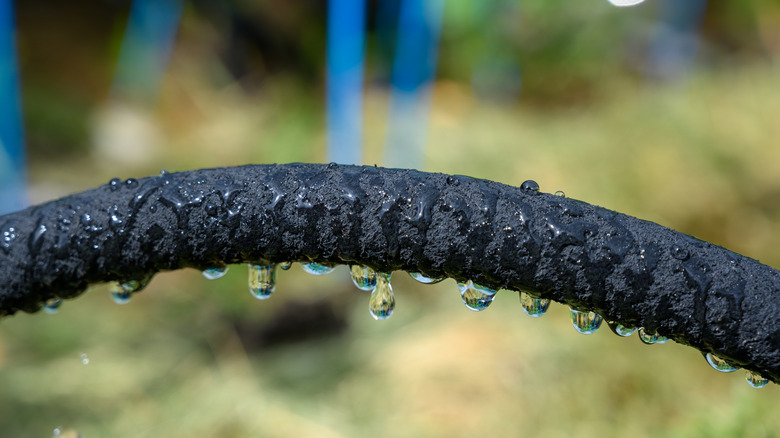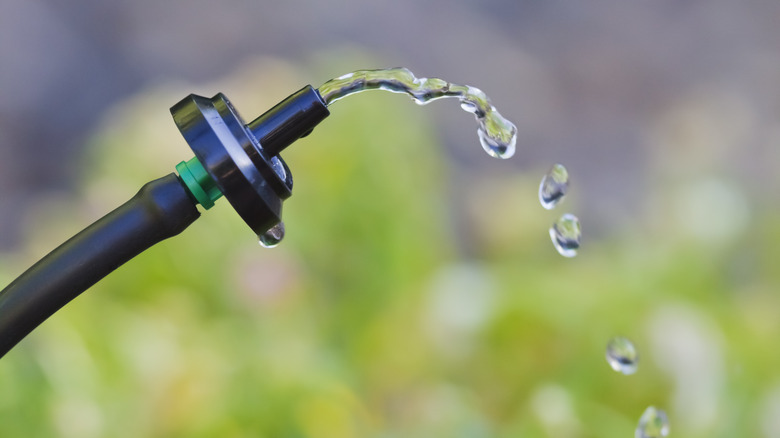Lawn sprinklers are a nostalgic tool that likely conjures childlike laughter and grass-covered toes, even though their purpose is to hydrate your lawn. While they can be useful for making your grass green and your flowers bloom, using a lawn sprinkler to water trees in your yard may not be the most effective method as it comes with several shortcomings that can negatively impact the health of the trees. Sprinklers are designed for even water distribution over a large, flat area, making them ideal for lawns but less suitable for tree watering. Trees require deep watering to encourage their roots to grow deep into the soil, providing stability and access to nutrients.
The main shortcoming of using a lawn sprinkler for tree watering is that it typically delivers water too superficially. The water may not penetrate the soil deeply enough to reach the tree’s root system, especially if the sprinkler is placed in the center of the lawn. Shallow watering can result in shallow root development, making the tree more susceptible to stress during periods of drought. Furthermore, lawn sprinklers often contribute to wasteful water usage. They can result in water evaporating before it reaches the tree roots, or runoff may occur on compacted soil. Inefficient water delivery can lead to malnourished trees, negatively impacting their overall health, growth, and resilience. Instead, it’s recommended to use methods that deliver water directly to the base of the tree with more efficient watering systems.
How to water trees with a soaker hose

A soaker hose is a specialized irrigation tool designed to efficiently water plants, including trees, by delivering water directly to the base of the plants. It is a porous hose that allows water to seep out slowly along its length. This design ensures a consistent and controlled flow of water, promoting deep root penetration and minimizing water wastage. To water a tree with a soaker hose, start by laying the hose in a spiral or loop around the tree, ensuring it covers the entire root zone. The hose should be positioned a few inches away from the trunk to prevent water from pooling directly at the base. Once the hose is in place, turn on the water source to allow a slow, steady stream of water to seep into the soil. It’s recommended to run the soaker hose for an extended period, around two hours, allowing the water to penetrate deeply into the ground.
This method offers several advantages over using a traditional lawn sprinkler for tree watering. The soaker hose delivers water directly to the root zone, promoting deep root growth. Unlike sprinklers that may water superficially, soaker hoses minimize surface evaporation and runoff, ensuring that a higher percentage of the water reaches the tree’s roots. Additionally, the slow, gradual release helps prevent soil erosion and compaction. Ultimately, this method contributes to the overall health of the tree, making it a preferable choice for effective tree watering.
Watering your tree with drip irrigation

Another alternative to the lawn sprinkler for watering your trees is a drip irrigation system. This method is a precise and efficient method of watering plants, including trees, by delivering water directly to the base of each plant through a network of tubing and emitters. In this system, water is distributed in small, controlled amounts, minimizing waste and promoting optimal moisture levels for plant growth. To water a tree with drip irrigation, you’ll need to strategically lay out a network of tubing around the tree with emitters placed near the root zone. Be sure to lay out the tubing as wide as the canopy stretches to account for all of the far-reaching roots. Once turned on, the emitters will release water slowly, allowing it to drip directly onto the soil. This targeted approach ensures that the tree’s root system receives a consistent and measured supply of water.
Compared to traditional sprinkler systems, drip irrigation offers several advantages for tree watering. Like a soaker hose, it reduces water wastage by delivering water precisely where it’s needed, minimizing runoff and evaporation. The slow and controlled release of water helps prevent soil erosion and surface compaction, promoting a healthier growing environment for the tree. By consistently providing water at the root zone, the system promotes the growth of strong and resilient roots that extend deeper into the soil. This depth is crucial for the tree’s stability, nutrient absorption, and overall health, especially during dry periods.



